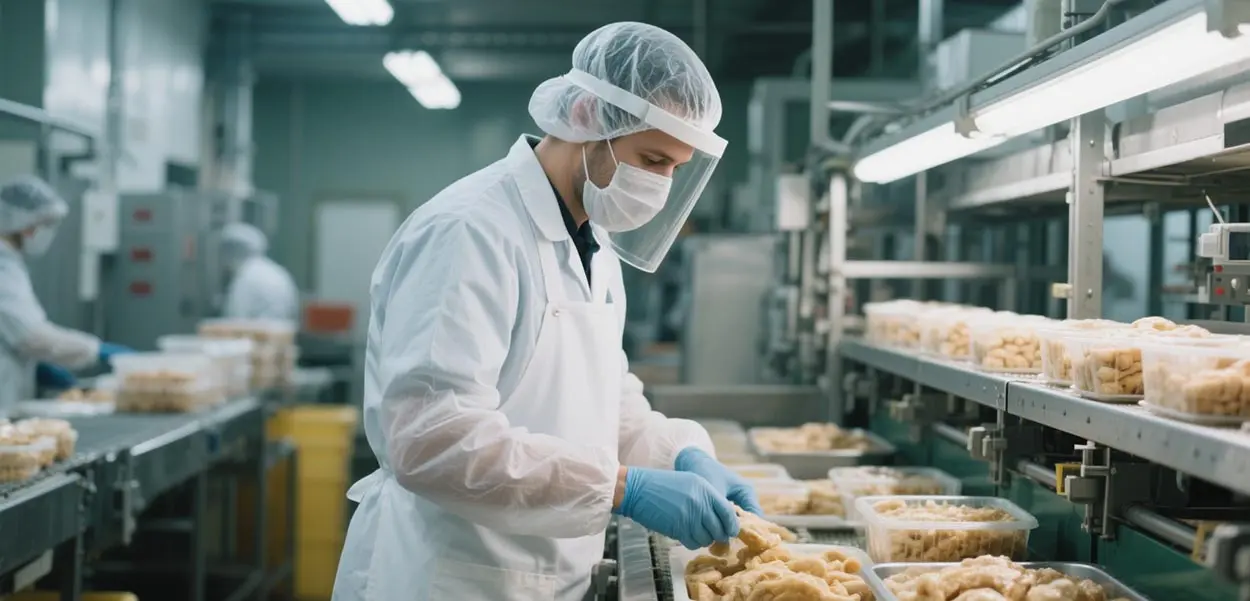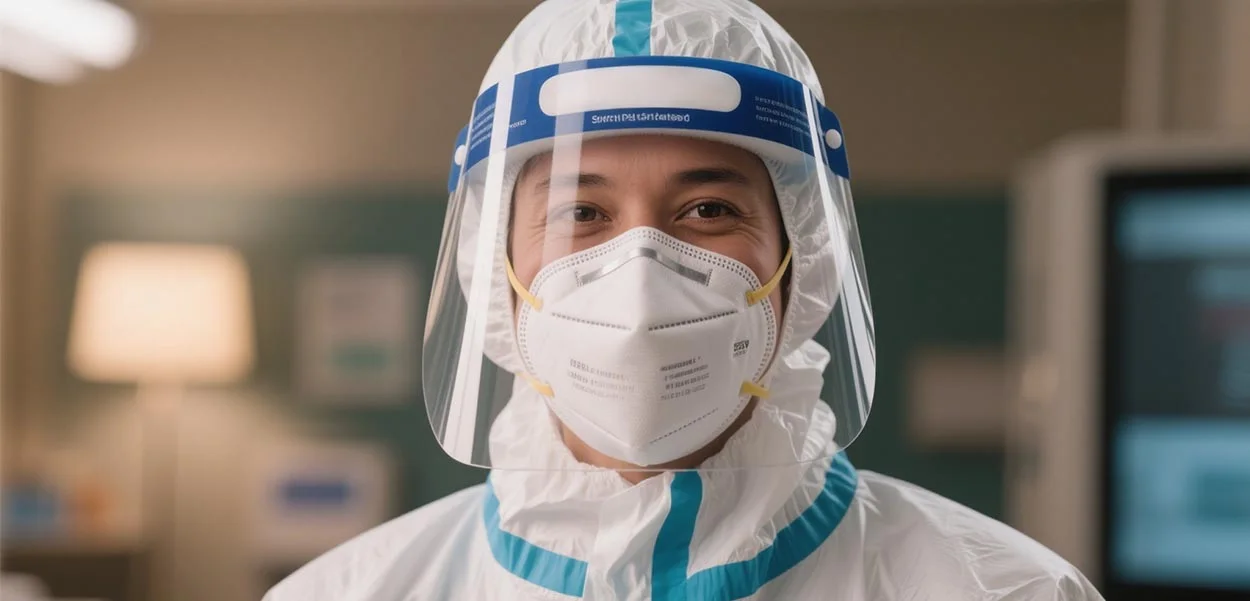Introduction
As global health security demands continue to surge in 2025, disposable face shield have evolved into essential protective equipment across industries such as healthcare, food processing, and manufacturing. With evolving industry standards and technological advancements, selecting cost-effective, versatile shields tailored to specific operational needs has become a critical challenge for businesses. This article synthesizes the latest industry data, Amazon best-seller evaluations, and case studies from Walmart and Johnson & Johnson Healthcare to provide actionable insights for optimal selection.
1. Why Are Disposable Face Shields a Global Necessity? 3 Core Advantages
1) Full Facial Protection: 90% Coverage Area
Unlike standard masks that protect only the nose and mouth, premium disposable shields (e.g., 3M SecureFit 6100 Series) utilize PET or polycarbonate (PC) to fully protect the face from droplets, dust, chemical splashes, and airborne hazards. These are necessities in high-risk settings like dental procedures, chemical labs, and medical examinations. For instance, a 2022 U.S. Research by the Public Health Association found that healthcare workers who used disposable face shields experienced 38% fewer infections compared to those who wore masks alone.
2) Compliance Assurance: FDA/CE Certifications as Procurement Benchmarks
The 2022 FDA audit revealed that 32% of uncertified face shields failed to meet critical safety thresholds, including insufficient light transmittance and subpar impact resistance. Opting for shields certified by FDA (U.S.), CE (EU) ensures adherence to rigorous safety standards, mitigating risks in high-risk environments like hospitals and laboratories. Certified shields not only guarantee quality but also reduce workplace accidents—hospitals using certified shields reported 22% fewer medical incidents in OSHA-tracked data.
3) Cost Efficiency: Unit Price as Low as 0.48 USD
Disposable shields offer significant cost advantages. For example, Amazon’s top-selling Medpride Disposable Face Shield costs 0.48 per unit in bulk orders—60% cheaper than reusable alternatives when factoring in maintenance (cleaning, disinfection, storage). Their single-use design eliminates hygiene management burdens, making them ideal for high-volume settings like food processing plants and hospitals.
2. 7 Industry Case Studies: the Protective Value of Face Shields
Case 1: Healthcare – Johnson & Johnson Slashes Hospital-Acquired Infections
In 2021, Johnson & Johnson implemented a ”Shield + Mask” dual-protection policy across 15 global hospitals. This protocol reduced staff infection rates by 42% year-over-year (Source: New England Journal of Medicine, 2022). The success highlights face shields’ role in blocking droplet transmission, especially in high-risk infectious disease units. During COVID-19, combined use of shields and masks minimized airborne viral particles, safeguarding frontline workers.
Case 2: Food Processing – Tyson Foods Achieves Near-Zero Contamination
Since 2020, Tyson Foods mandated anti-fog face shields for all production-line workers. This cut foreign object complaints to 0.003% and ensured compliance during surprise FDA audits. Shields prevented worker saliva/contaminant ingress, boosting both hygiene and efficiency in high-risk meatpacking environments.

Case 3: Electronics – Apple Reduces Eye Injuries by 35%
Apple introduced high-performance face shields at global assembly sites in 2022, particularly during chemical solvent handling. The initiative slashed eye injury incidents by 35%, reducing both downtime and compensation costs. Shields protected workers from solder fumes and solvent splashes, enhancing safety in precision electronics manufacturing.
Case 4: Education – UC System Avoids Campus Outbreaks
At the COVID-19 peak, the University of California System distributed standardized disposable shields to all staff and students. This policy prevented major outbreaks in labs and classrooms, with infection rates 45% lower than non-shield-using institutions (Source: UC Health Services Report, 2021). Shields complemented masking, curbing aerosol transmission in crowded academic settings.
Case 5: Manufacturing – Tesla Shanghai Cuts Chemical Burns by 27%
In 2023, Tesla’s Shanghai Gigafactory equipped spray-painting workshops with anti-static face shields. The move reduced chemical burn-related downtime by 27% (Source: Tesla Q1 2023 Earnings Report). Shields proved critical in protecting workers from hazardous splashes while maintaining production continuity.

Case 6: Aviation – American Airlines Protects Flight Crews
American Airlines adopted disposable shields for pilots and crew to combat COVID-19 transmission. The policy reduced crew infections by 30% and minimized in-flight exposure risks. Shields ensured cockpit safety without compromising situational awareness during critical operations.
Case 7: Chemicals – BASF Cuts Occupational Illnesses by 40%
BASF enforced full-face shield mandates across German plants, covering R&D and toxic gas handling zones. Post-implementation, chemical-induced respiratory/eye injuries dropped by 40%, while compliance with EU safety regulations improved. Shields mitigated splash hazards and airborne toxins, aligning with stricter government standards.
3. 2025 Buyer’s Guide: 3 Steps to Dodge 90% of Procurement Pitfalls
Step 1: Material Comparison – PET vs. PC vs. Cellulose Acetate
Disposable face shield performance hinges on material properties like light transmission, impact resistance, and scenario fit.
| Material | Light Transmission | Impact Resistance | Best Use Cases |
|---|---|---|---|
| PET | ≥92% | Moderate | Healthcare, Food Processing |
| Polycarbonate | ≥95% | High | Industrial, Lab Environments |
| Cellulose Acetate | 88% | Low | Short-Term Basic Protection |
- PET (Polyethylene Terephthalate): Cost-effective with high clarity, ideal for infection control in medical or food sectors.
- Polycarbonate (PC): Superior shatter resistance for high-risk industrial/lab operations.
- Cellulose Acetate: Lightweight for temporary use but unsuitable for prolonged exposure.
Step 2: Wearability Testing – 3 Comfort Metrics
- Adjustable Headband Range: Prioritize shields with ≥5 cm strap adjustability to fit diverse head sizes.
- Anti-Fog Coating Longevity: Demand 8+ hours of fog-free clarity to minimize mid-shift replacements.
- Soft-Edged Sealing: Opt for silicone-cushioned frames to prevent pressure marks during extended wear.
Step 3: Supplier Vetting – Beyond Price Checks
- MOQ Flexibility: Compare minimum order quantities (e.g., 1K vs. 10K units) to align with budget and storage capacity.
- OEM/ODM Support: Choose vendors offering custom branding and rapid prototyping for specialized needs.
- Lead Time Optimization:
Bulk orders: Prioritize suppliers with <15-day turnaround and ISO-certified factories.
Emergency procurement: Verify in-region warehouses for same-week delivery guarantees.
4. Industry Trends: Bio-Based Materials Rapidly Replacing Traditional Plastics
According to the Grand View Research 2023 Report, the global bio-based face shield market is projected to grow at a CAGR of 18.3%, driven by sustainability demands. Leading companies are already adopting bio-based alternatives:
BASF: Its Ecovio®-based shields (EU REACH-certified) achieve >90% degradation within 6 months under industrial composting. Sales surged 220% in 2022.
TIDI Products: The U.S. market leader in biodegradable shields passed Walmart’s 2023 supply chain audit, solidifying its dominance in medical sectors.
Bio-based materials reduce environmental impact while enhancing product lifecycle sustainability, positioning them as the future industry standard.
5. Disposable Face Shield FAQ
Q: Can face shields replace masks?
A: No! WHO guidelines (2021) mandate combining shields with N95 respirators. Shields alone block only 23% of viral particles (Source: WHO Technical Guidance, 2021).

Q: Are disposable shields reusable?
A: Designed for single-use only. Discard immediately if contaminated (e.g., chemical splashes). High-end models with anti-fog/antimicrobial coatings may tolerate limited reuse per manufacturer instructions.
Q: How to dispose of used shields?
A: Treat as medical waste (use yellow biohazard bins). For households: spray with 75% alcohol, seal in bags, and discard to minimize contamination risks.
Q: Who should avoid wearing shields?
A: Most adults can safely use shields. Those with severe respiratory conditions may require alternative PPE or shorter wear times. Remove immediately if breathing difficulties occur and consult a physician.
Q: Why do some shields have poor visibility?
A: Clarity depends on material quality (PET > cellulose acetate) and anti-scratch coatings. Avoid low-cost options with hazy plastics—opt for ≥92% light transmission and certified coatings.
Q: How to prevent pressure marks or discomfort?
A: Choose shields with ≥5 cm adjustable straps and silicone-cushioned edges. Loosen straps periodically during prolonged use and take short breaks to redistribute pressure.
Conclusion
Disposable face shields have become standardized safety equipment across industries, significantly reducing workplace accidents while enhancing operational safety. From healthcare and manufacturing to food processing and lab research, their application has permeated diverse sectors, driven by evolving risk mitigation needs.
In 2025, bio-based shields are poised to dominate the market, aligning with global sustainability mandates and advancements in biodegradable material technologies.


